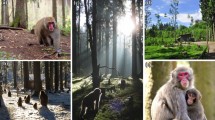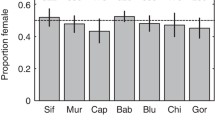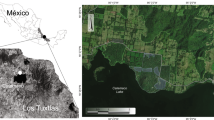Abstract
Based on long-term, although intermittent, observations (2 years 4 months of 14 years), we present data on birth seasonality, age at first birth, interbirth intervals, mortality rates, age at first emigration, and population change of a wild population of West African patas monkeys (Etythrocebus patas patas) in northern Cameroon. Birth season was from the end of December until the middle of February, corresponding to the mid-dry season. In spite of large body size, the patas females had the earliest age at first birth (36.5 monthsold) and the shortest interbirth intervals (12 months) compared to the closely related wild forest guenons. Age at first emigration of the males was considered to occur between 2.5 and 4.5 years. The group size of the focal group drastically decreased between 1984 and 1987, and steadily increased until 1994, then decreased again in 1997. The neighboring group also showed a similar trend in group size. The population decreases were likely to be caused by drought over 3 years. Annual crude adult mortality rate was 4% during population increase periods (PIP) between 1987 and 1994. It rose to 22% during all the periods (AP), including drought over 3 years. Despite their smaller body size, the rate of the wild forest guenons (Cercopithecus mitis) (4%) was the same and much lower than those of the patas during PIP and AP, respectively. The annual average juvenile mortality rate was 13% during PIP and it also rose to 37% during AP. That of wild forest guenons (C. ascanius) (10–12%) was a little lower and much lower than those of the patas during PIP and AP, respectively. These findings were consistent with Charnov's theoretical model of mammalian life-history evolution in that patas with high adult and juvenile mortality showed early and frequent reproduction in spite of large body size. Charnov also considered high adult mortality as a selective force and high juvenile mortality as a density-dependent consequence of high fecundity. Our results support the former but not the latter research findings.





Similar content being viewed by others
References
Bronson FH (1985) Mammalian reproduction: an ecological perspective. Biol Reprod 32:1–26
Butynski TM (1988) Guenon birth seasons and correlates with rainfall and food. In: Gautier-Hion A, Bourlière F, Gautier J-P, Kingdon J (eds) A primate radiation: evolutionary biology of the african guenons. Cambridge University Press, New York, pp 284–322
Charlesworth B (1980) Evolution in age structured populations. Cambridge University Press, Cambridge
Charnov EL (1991) Evolution of life history among female mammals. Proc Natl Acad Sci USA 88:1134–1137
Charnov EL, Brrigan D (1990) Dimensionless numbers and life history evolution: age at maturity versus the adult lifespan. Evol Ecol 4:273–275
Chism J, Rowell TE, Olson D (1984) Life history patterns of female patas monkeys. In: Small M (ed) Female primates: studies by women primatologists. Liss, New York, pp 175–190
Cords M (1987) Forest guenons and patas monkeys: male-male competition in one-male groups. In: Smuts BB, Cheney DL, Seyfarth RM, Wrangham RW, Struhsaker TT (eds) Primate Societies. University of Chicago Press, Chicago, pp 98–111
Cords M, Rowell TE (1987) Birth intervals of Cercopithecus monkeys of the Kakamega forest, Kenya. Primates 28:277–281
Dittus W (1975) Population dynamics of the toque monkey, Macaca sinica. In: Tuttle RH (ed) Socioecology and psychology of primates. Mouton, Paris, pp 125–151
Dunbar RIM (1988) Primate social systems. Croom Helm, London
Folland CK, Palmer TN, Parker DE (1986) Sahel rainfall and worldwide sea temperature, 1901–86. Nature 320:602–607
Harvey PH, Martin RD, Clutton-Brock TH (1987) Life histories in comparative perspective. In: Smuts BB, Cheney DL, Seyfarth RM, Wrangham RW, Struhsaker TT (eds) Primate society. University of Chicago Press, Chicago, pp 181–196
Kavanagh M (1978) National park in the sahel. Oryx 14:241–245
Lee PC, Bowman JE (1995) Influence of ecology and energetics on primate mothers and infants. In: Pryce CR, Martin RD, Skuse D (eds) Motherhood in human and nonhuman primates. Karger, Basel, pp 47–58
Lindburg DJ (1987) Seasonality of reproduction in primates. In: Mithchell G, Erwin J (eds) Comparative primate biology, vol. 2b. Behavior, cognition, and motivation. Liss, New York, pp 167–218
Loy J (1981) The reproductive and heterosexual behaviours of adult patas monkeys in captivity. Anim Behav 29:714–726
Milton K (1996) Effects of bot fly (Alouattamyia baeri) parasitism on a free-ranging howler (Alouatta palliata) population in Panama. J Zool (Lond) 239:39–63
Nakagawa N (1989) Activity budget and diet of patas monkeys in Kala Maloue National Park, Cameroon: a preliminary report. Primates 30:27–34
Nakagawa N (1991) Comparative feeding ecology of patas monkeys and tantalus monkeys in Kala Maloue National Park. In: Ehara A, Kimura T, Takenaka O, Iwamoto M (eds) Primatology today. Elsevier, Amsterdam, pp 119–122
Nakagawa N (1999) Differential habitat utilization by patas monkeys (Erythrocebus patas) and tantalus monkeys (Cercopithecus aethiops tantalus), living sympatrically in northern Cameroon. Am J Primatol 49:243–264
Nakagawa N (2000) Foraging energetics in patas monkeys (Erythrocebus patas) and tantalus monkeys (Cercopithecus aethiops tantalus): implications for reproductive seasonality. Am J Primatol 52:169–185
Ohsawa H, Inoue M, Takenaka O (1993) Mating strategy and reproductive success of male patas monkeys (Erythrocebus patas). Primates 34:533–544
Pianka ER (1970) On r and K selection. Am Nat 104:592–597
Purvis A, Harvey PH (1995) Mammal life-history evolution: a comparative test of Charnov's model. J Zool (Lond) 237:259–283
Ross C (1988) The intrinsic rate of natural increase and reproductive effort in primates. J Zool (Lond) 214:199–219
Ross C (1992a) Environmental correlates of the intrinsic rate of natural increase in primates. Oecologia 90:383–390
Ross C (1992b) Life history patterns and ecology of macaque species. Primates 33:207–215
Ross C (1998) Primate life histories. Evol Anthropol 6:54–63
Ross C, Jones KE (1999) Socioecology and the evolution of primate reproductive rates. In: Lee PC (ed) Comparative primate socioecology. Cambridge University Press, Cambridge, pp 73–110
Rowell TE, Richards SM (1979) Reproductive strategies of some African monkeys. J Mammal 60:58–69
Rutberg AT (1987) Adaptive hypotheses of birth synchrony in ruminants: an interspecific test. Am Nat 130:692–710
Sade DS, Cushing K, Cushing P, Dunaif, J, Figueroa A, Kaplan JR, Laurer C, Rhodes D, Schneider J (1976) Population dynamics in relation to social structure on Cayo Santiago. Yearb Phys Anthropol 20:253–262
Schaffer WM (1974) Optimal reproductive effort in fluctuating environments. Am Nat 108:783–790
Struhsaker TT, Pope TR (1991) Mating system and reproductive success: a comparison of two African forest monkeys (Colobus badius and Cercopithecus ascanius). Behaviour 117:182–205
Strum SC, Western D (1982) Variations in fecundity with age and environment in olive baboons (Papio anubis). Am J Primatol 3:61–76
Sugiyama Y (1994) Age-specific birth rate and lifetime reproductive success of chimpanzees at Bossou, Guinea. Am J Primatol 32:311–318
Sugiyama Y, Ohsawa H (1982) Population dynamics of Japanese monkeys with special reference to the effect of artificial feeding. Folia Primatol 39:238–263
Swart J, Lawes MJ, Perrin MR (1993) A mathematical model to investigate the demographic viability of low-density samango monkeys (Cercopithecus mitis) populations in Natal, South Africa. Ecol Model 70:289–303
Acknowledgements
We are grateful to MINREST, IRA, and MINEF, Republic of Cameroon, for permission to conduct research in Kala Maloue National Park. The project has been continuously encouraged by Professors Emeritus M. Kawai and Y. Sugiyama as directors of the Kyoto University Primate Research Team in Cameroon. Our field work was greatly facilitated by assistance from Dr. V. Hayes. Rainfall data collected by the Meteorological Station, Kousseri in Cameroon and Ndjamena Airport in Chad, was provided by Professor Emeritus H. Kadomura. Helpful suggestions and discussions were the contribution of Drs. L.A. Isbell, T.P. Young, S. Miura, and two anonymous reviewers. Funding has been provided by grants of the Ministry of Education, Science, and Culture, Japan (62041055, 01041058, 04041066 to Y. Sugiyama; 63041140 to M. Kawai; 08041145 to H.O.) and by Kyoikusha, Tokyo.
Author information
Authors and Affiliations
Corresponding author
About this article
Cite this article
Nakagawa, N., Ohsawa, H. & Muroyama, Y. Life-history parameters of a wild group of West African patas monkeys (Erythrocebus patas patas). Primates 44, 281–290 (2003). https://doi.org/10.1007/s10329-003-0042-z
Received:
Accepted:
Published:
Issue Date:
DOI: https://doi.org/10.1007/s10329-003-0042-z




